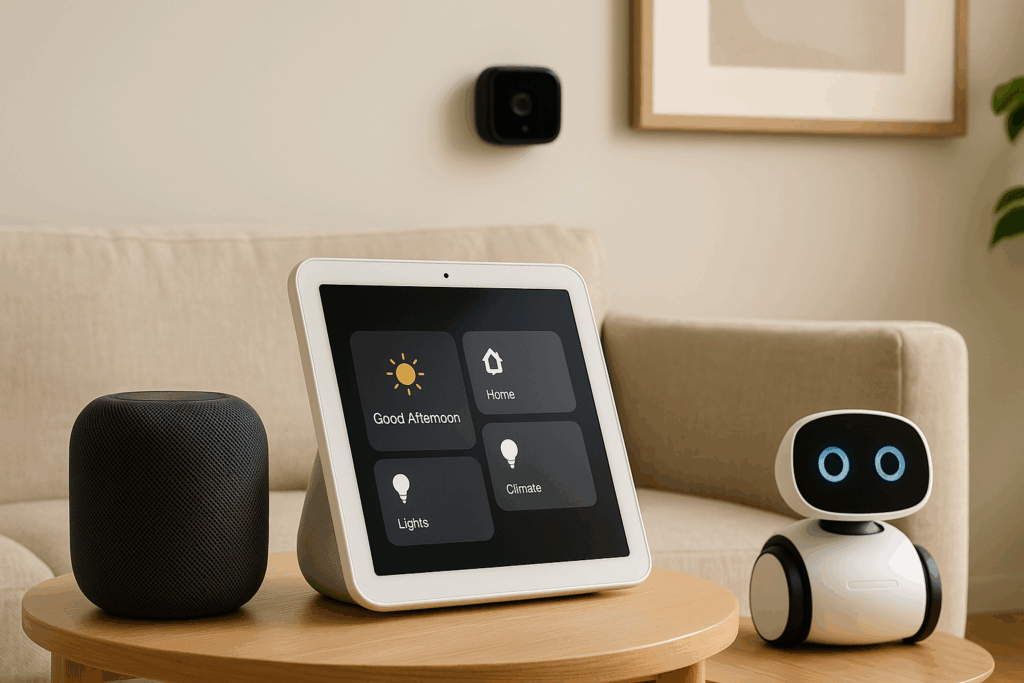Apple leaps into smart home tech what’s coming next
When I visited a friend’s house last month, her lights dimmed, curtains closed, and coffee maker started all prompted by a simple “Good night” command. She looked at me wide-eyed: “I swear, it feels like the house is alive now.” That’s what matters: the magic comes when your home starts thinking for you.
Here’s the thing: Apple entering the smart home arena in earnest isn’t just another gadget launch it’s a pivot that could redraw the rules in home automation.
Why Apple? What’s changed
Apple has flirted with smart home tech before HomeKit, HomePod, Home app but mostly as a side show. Now it seems ready to lead.
Recent leaks suggest Apple is planning a smart home hub with display (around 7-inch), possibly in both tabletop and wall-mounted versions.
It’s also building indoor security cameras, and later even a robotic assistant for your home.
Manufacturing will shift to Vietnam, reducing dependence on China.
A price tag of around $350 is being floated for the hub.
What this means is Apple is trying to insert itself as the “brain” of your home not just another component.
Myth: Apple doing home is just for prestige
No they’ve clearly mapped a path. The hub + cameras + robot path shows they want a full ecosystem, not a one-off product.
What problems Apple is trying to solve (and faces)
1. Fragmentation & interoperability
Smart homes are messy: different brands, standards, protocols. Apple’s HomeKit and its adoption of Matter help unify this.
Tip: If Apple nails smooth interop (especially with non-Apple devices), it will win trust quickly.
2. Voice assistant weakness
Siri has lagged behind Alexa, Google Assistant. The hub’s success depends on a smarter Siri one that understands context, remembers conversations.
Common mistake: Launching smart devices without upgrading the intelligence layer you end up with fancy hardware but dumb behavior.
3. Privacy, security, and trust
Apple’s privacy reputation gives it an edge. But cameras and always-listening mic devices raise red flags. They’ll need clear policies, local processing, encryption.
4. Cost and adoption
$350 is premium. Many smart home products are budget friendly. Apple must justify the cost by offering something no one else can.
Tip: Early adopters will pay. But mainstream users need killer features (easy setup, high reliability).
How Apple’s play stacks vs Amazon / Google
| Strategy | Apple’s Strength | Weakness / Risk |
| Ecosystem leverage | iPhone, iPad, macOS many existing users | Many homes include non-Apple devices |
| Privacy branding | Can emphasize local processing and data control | Cameras invite scrutiny; failure is public |
| Hardware + software integration | Apple knows how to polish end-to-end | Mistakes in hardware design or reliability hurt reputation |
| Platform control | Can dictate APIs, hardware relationships | Being too closed can frustrate the community |
Tip: Apple’s best bet is to enforce a “golden path” the experience for users who stay within Apple’s ecosystem should be smooth, while still tolerating external devices.
What this means for you (as a consumer or tech fan)
If you’re an Apple user
You might finally get a home hub that just works one you don’t have to fight. Smart home becomes less of a hobby, more of a utility.
If you own non-Apple gear
The big question: will your devices be supported? The better Apple’s support for open standards (Matter, Thread), the fewer walls you’ll hit.
For early adopters
This is your moment. You can try next-gen gear, test integrations, report bugs. (Just brace for growing pains you’re helping shape what comes next.)
Checklist: What to watch in Apple’s smart home rollout
- Interoperability How many third-party devices will just work out-of-box?
- Siri evolution Can it converse naturally, infer context, multi-step logic?
- Local processing & privacy How much data stays in your home?
- User interface & setup Simple initial setup, recovery from failures.
- Ecosystem lock-in vs openness Will Apple encourage or discourage non-Apple integrations?
Final thoughts & next step
Apple jumping into smart home tech is big. Not just because of the gear, but because it signals confidence that smart homes are ready for prime time.
If you own Apple devices, this could simplify and unify your life. If you build smart home products or apps, you’ll want to align early with what Apple supports.



